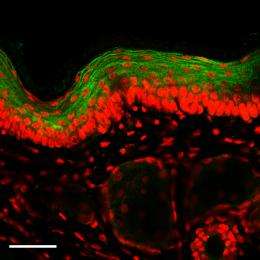February 15, 2011 report
Stem cells released to heal wounds could trigger tumors

(PhysOrg.com) -- Research in mice has found that mutated stem cells can migrate to the surface of injured skin, where they can trigger the growth of tumors.
Biochemists Sunny Wong and Jeremy Reiter of the University of California, San Francisco studied the commonest type of skin cancer, basal cell carcinoma, in a mouse model to determine if stem cells were involved. They were interested in the possibility because in some ways basal cell carcinoma mimics the actions of stem cells that repair skin damage, growing slowly and sometimes transforming into other kinds of cells.
The researchers activated a mutated version of Smoothened (Smo), an oncogene (a gene that can cause cancer when it mutates) that is sometimes found mutated in human basal cell carcinoma. They found that when the gene, which is in cells in the lower skin layers at the skin hair follicles, was activated the rate of carcinoma did not increase. When they injured the mice by removing a small section of skin from their backs after activating the gene, the mice developed tumors similar to basal cell carcinomas around the site of the injury.
They found that the stem cells with the activated gene remained near the follicles in the first experiments, but in the second, the stem cells migrated to the upper layers of skin to repair the wound. While in the epidermis the stem cells seeded the growth of tumors by disrupting a biochemical signaling pathway thought to be involved in the development of basal cell carcinomas. They continued to seed tumor growth for up to five weeks, even when the injury was as minor as a paper cut.
The research, soon to be published in the Proceedings of the National Academy of Sciences (PNAS), suggests that mutated genes in the skin stem cells could remain dormant for years and only begin to seed tumor growth after the skin is damaged. Dr Wong, a postdoctoral research fellow, said the pre-cancerous cells could lie dormant until there is a trigger, such as radiation, that takes them out of their dormant stage.
Several cancers are associated with injuries, such as Marjolin’s ulcer, a type of tumor that can develop after war injuries, but this is the first study to suggest injuries could be involved in the development of some skin cancers.
Dr Reiter said the first experiment offers some hope because even when the gene was activated it did not cause tumors to grow unless there was an injury. He cautioned that the research should not cause concern over every minor cut, and said only a “tiny fraction” of wounds ever result in tumor growth. The current research helps in the understanding of the process by which normal healing can sometimes go awry.
© 2010 PhysOrg.com
















